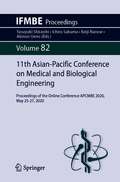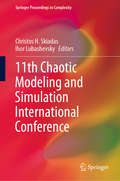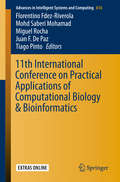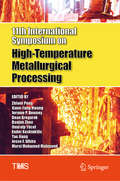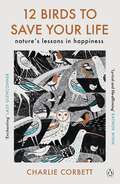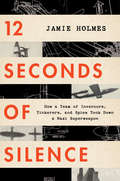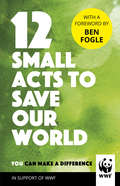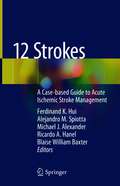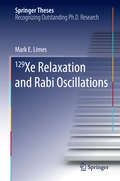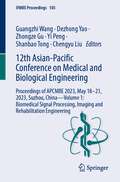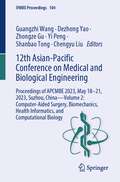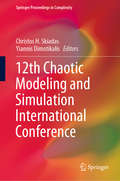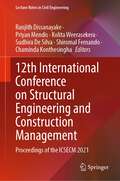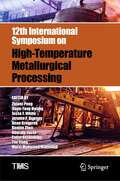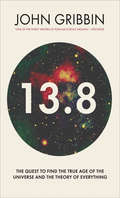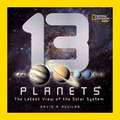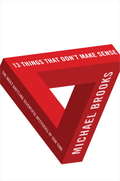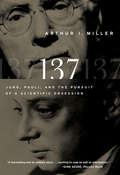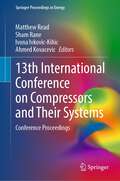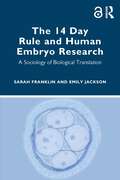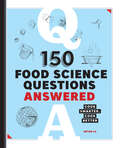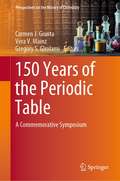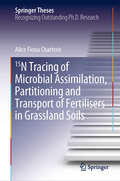- Table View
- List View
11th Asian-Pacific Conference on Medical and Biological Engineering: Proceedings of the Online Conference APCMBE 2020, May 25-27, 2020 (IFMBE Proceedings #82)
by Yasuyuki Shiraishi Ichiro Sakuma Keiji Naruse Akinori UenoThis book presents cutting-edge research and developments in the field of medical and biological engineering, which a special emphasis on activities carried out in the Asian-Pacific region. Gathering the proceedings of the 11th Asian-Pacific Conference on Medical and Biological Engineering, organized in Japan and held online on May 25-27, 2020, the book both fundamental research and clinical applications relating to medical instrumentations, bioimaging, bioinformatics and computational biomedicine, AI and data science in healthcare, as well as regenerative medicine and rehabilitation. It aims at informing on new trends, challenges and solutions, and fosters communication and collaboration between medical scientists, engineers, and researchers dealing with cutting-edge themes in broad field of biomedical and clinical engineering.
11th Chaotic Modeling and Simulation International Conference (Springer Proceedings in Complexity)
by Christos H. Skiadas Ihor LubashevskyGathering the proceedings of the 11th CHAOS2018 International Conference, this book highlights recent developments in nonlinear, dynamical and complex systems. The conference was intended to provide an essential forum for Scientists and Engineers to exchange ideas, methods, and techniques in the field of Nonlinear Dynamics, Chaos, Fractals and their applications in General Science and the Engineering Sciences. The respective chapters address key methods, empirical data and computer techniques, as well as major theoretical advances in the applied nonlinear field. Beyond showcasing the state of the art, the book will help academic and industrial researchers alike apply chaotic theory in their studies.
11th International Conference on Practical Applications of Computational Biology & Bioinformatics (Advances in Intelligent Systems and Computing #616)
by Florentino Fdez-Riverola Juan F. De Paz Mohd Saberi Mohamad Miguel Rocha Tiago PintoBiological and biomedical research are increasingly driven by experimental techniques that challenge our ability to analyse, process and extract meaningful knowledge from the underlying data. The impressive capabilities of next-generation sequencing technologies, together with novel and constantly evolving, distinct types of omics data technologies, have created an increasingly complex set of challenges for the growing fields of Bioinformatics and Computational Biology. The analysis of the datasets produced and their integration call for new algorithms and approaches from fields such as Databases, Statistics, Data Mining, Machine Learning, Optimization, Computer Science and Artificial Intelligence. Clearly, Biology is more and more a science of information and requires tools from the computational sciences. In the last few years, we have seen the rise of a new generation of interdisciplinary scientists with a strong background in the biological and computational sciences. In this context, the interaction of researchers from different scientific fields is, more than ever, of foremost importance in boosting the research efforts in the field and contributing to the education of a new generation of Bioinformatics scientists. The PACBB'17 conference was intended to contribute to this effort and promote this fruitful interaction, with a technical program that included 39 papers spanning many different sub-fields in Bioinformatics and Computational Biology. Further, the conference promoted the interaction of scientists from diverse research groups and with a distinct background (computer scientists, mathematicians, biologists).
11th International Symposium on High-Temperature Metallurgical Processing (The Minerals, Metals & Materials Series)
by Dean Gregurek Baojun Zhao Tao Jiang Jiann-Yang Hwang Zhiwei Peng Onuralp Yücel Ender Keskinkilic Jerome P. Downey Morsi Mohamed Mahmoud Jesse F. WhiteIn recent years, global metallurgical industries have experienced fast and prosperous growth. High-temperature metallurgical technology is the backbone to support the technical, environmental, and economical needs for this growth. This collection features contributions covering the advancements and developments of new high-temperature metallurgical technologies and their applications to the areas of processing of minerals; extraction of metals; preparation of refractory and ceramic materials; sintering and synthesis of fine particles; treatment and recycling of slag and wastes; and saving of energy and protection of environment. The volume will have a broad impact on the academics and professionals serving the metallurgical industries around the world.
12 Birds to Save Your Life: Nature's Lessons in Happiness
by Charlie CorbettDiscover the healing power of nature through the stories of these characterful birds, whose song is never far away . . .LONGLISTED FOR THE 2022 WAINWRIGHT PRIZE'A lyrical and life-affirming book that teaches us as much about birds as it does ourselves - a balm for the soul' Raynor Winn, author of The Salt Path'Totally absorbing and completely engaging on so many levels . . . Charlie has opened my eyes to the constant joy of the sights and sounds of the birds that surround us. It is a book that really will save lives' Dr Richard Shepherd, author of Unnatural Causes_________After the tragic loss of his mother, Charlie Corbett felt trapped by his pain. Having lost all hope and perspective he took to the countryside in search of solace. There, he heard the soaring, cascading song of the skylark - a sound that pulled him from the depths of despair and into the calm of the natural world.Weaving his journey through grief with a remarkable portrait of the birds living right on our doorstep, 12 Birds to Save Your Life is an invitation to stop, step outside, and listen. By following Charlie's path, opening your eyes and ears to what has been there all along, you will discover how nature can set you free.
12 Seconds of Silence: How a Team of Inventors, Tinkerers, and Spies Took Down a Nazi Superweapon
by Jamie HolmesThe riveting story of the American scientists, tinkerers, and nerds who solved one of the biggest puzzles of World War II—and developed one of the most powerful weapons of the war 12 Seconds of Silence is the remarkable, lost story of how a ragtag group of American scientists overcame one of the toughest problems of World War II: shooting things out of the sky. Working in a secretive organization known as Section T, a team of physicists, engineers, and everyday Joes and Janes took on a devilish challenge. To help the Allies knock airplanes out of the air, they created one of the world&’s first &“smart weapons.&” Against overwhelming odds and in a race against time, mustering every scrap of resource, ingenuity, and insight, the scientists of Section T would eventually save countless lives, rescue the city of London from the onslaught of a Nazi superweapon, and help bring about the Axis defeat. A holy grail sought after by Allied and Axis powers alike, their unlikely innovation ranks with the atomic bomb as one of the most revolutionary technologies of the Second World War. Until now, their tale was largely untold. For fans of Erik Larson and Ben Macintyre, set amidst the fog of espionage, dueling spies, and the dawn of an age when science would determine the fate of the world, 12 Seconds of Silence is a tribute to the extraordinary wartime mobilization of American science and the ultimate can-do story.
12 Small Acts to Save Our World: Simple, Everyday Ways You Can Make a Difference
by WWF_______________________________— Ever wanted to save the world? —It’s easy to feel like we can’t make a difference. But small, easy actions, if taken by enough people, can move mountains – and save planets.Written in collaboration with leading environmental experts from WWF, this short book provides simple changes we can all make to our everyday lives, from morning to night.These aren’t the only things you can do. Nor are they things you have to do. But these 12 small acts are basic steps anybody can take, and if even one of them sticks, our children will inherit a better world.Acts like:– Turning off devices instead of leaving them on standby– Buying less cotton clothing (a T-shirt needs 2,400 litres of water to make!)– Using reusable straws when possible– Turning off the tap while you brush your teethwill take only moments, but if enough people commit to them, we can make a real difference to our planet._______________________________'Now really is the time to act. You don’t have to be a superhero – everyone can make a difference by following this book’ – Ben Fogle
12 Strokes: A Case-based Guide to Acute Ischemic Stroke Management
by Ferdinand K. Hui Alejandro M. Spiotta Michael J. Alexander Ricardo A. Hanel Blaise William BaxterThis comprehensive, case-based resource provides the state-of-the-art knowledge that can help readers improve access and optimize delivery of stroke thrombectomy. Improving access to stroke is of particular importance because patients often misinterpret their symptoms or cannot speak for themselves if they have aphasia. More importantly, access needs to be organized because stroke therapies are all extremely time-sensitive. Scalable, choreographed protocols are necessary for emergency medical systems to ‘capture’ stroke patients and automatically transport and triage to time-sensitive treatments. Many of the chapters in the first section on Fundamentals and Systems provide valuable insight in improving access to stroke care. Replete with illustrative case studies and emphasizing that treatment approaches to stroke should not be comprised of a one-size-fits-all approach, this illuminating title provides the complete thought, detail, insight and organization that will help readers meet the needs of stroke patients with large vessel occlusions. 12 Strokes: A Case-based Guide to Acute Ischemic Stroke Management examines the primary technical principles that underlie the current thrombectomy approaches. Instead of continuing the conceptual dichotomy of stent vs. aspiration, many of the chapters look at underlying principles and then discuss ways in which the currently available devices and approaches can best exploit them. The variety, creativity and detail in many of these chapters will help the reader develop a deeper understanding that might assist their ability to successfully take care of their next patient that ‘doesn’t follow the textbook.’ In addition, the anatomic and pathophysiologic classification of the core Twelve Chapters will help readers organize their thinking and approach. This knowledge, particularly because it is organized based on common, challenging syndromes, will arm the reader to quickly recognize patterns and deftly adapt their management approaches to the needs of the patient. An invaluable contribution to the clinical literature, 12 Strokes: A Case-based Guide to Acute Ischemic Stroke Management will be of great interest to not only neurosurgeons and neurologists but other specialists, primary care providers, and trainees as well.
129 Xe Relaxation and Rabi Oscillations (Springer Theses)
by Mark E. LimesThis thesis describes longitudinal nuclear relaxation measurements of solid 129Xe near 77 K with previously unattainable reproducibility, and demonstrates differences in relaxation, dependent upon the way in which the solid is condensed. These results are directly applicable to the generation and storage of large quantities of hyperpolarized 129Xe for various applications, such as lung magnetic resonance imaging (MRI). The thesis features a sophisticated theoretical approach to these data sets, including modifications to a well-established Raman-phonon scattering theory that may explain the larger scatter in and discrepancies with previous work.
12th Asian-Pacific Conference on Medical and Biological Engineering: Proceedings of APCMBE 2023, May 18–21, 2023, Suzhou, China—Volume 1: Biomedical Signal Processing, Imaging and Rehabilitation Engineering (IFMBE Proceedings #103)
by Guangzhi Wang Dezhong Yao Zhongze Gu Yi Peng Shanbao Tong Chengyu LiuThis book presents cutting-edge research and developments in the field of medical and biological engineering, which a special emphasis on activities carried out in the Asian-Pacific region. Gathering the proceedings of the 12th Asian-Pacific Conference on Medical and Biological Engineering (APCMBE 2023), held on May 18–21, 2023, in Suzhou, China, this first volume of a two-volume set focuses on biomedical imaging and signal processing, biomedical sensing and wearables, and rehabilitation and neural engineering. All in all, this book offers extensive information on the state-of-the-art solutions and challenges in biomedical and clinical engineering, addressing a broad audience of medical scientists, engineers, physicists and other researchers and professionals.
12th Asian-Pacific Conference on Medical and Biological Engineering: Proceedings of APCMBE 2023, May 18–21, 2023, Suzhou, China—Volume 2: Computer-Aided Surgery, Biomechanics, Health Informatics, and Computational Biology (IFMBE Proceedings #104)
by Guangzhi Wang Dezhong Yao Zhongze Gu Yi Peng Shanbao Tong Chengyu LiuThis book presents cutting-edge research and developments in the field of medical and biological engineering, which a special emphasis on activities carried out in the Asian-Pacific region. Gathering the proceedings of the 12th Asian-Pacific Conference on Medical and Biological Engineering (APCMBE 2023), held on May 18–21, 2023, in Suzhou, China, this second volume of a two-volume set covers advances in computer-aided surgery, biomechanics and micro-nanoengineering, health informatics and health engineering, as well as computational modeling and simulation, as well as AI applications in biology and medicine. It addresses a broad audience of researchers and professionals active in biomedical engineering, biomechanics, medical biophysics, and health informatics.
12th Chaotic Modeling and Simulation International Conference (Springer Proceedings in Complexity)
by Christos H. Skiadas Yiannis DimotikalisGathering the proceedings of the 12th CHAOS2019 International Conference, this book highlights recent developments in nonlinear, dynamical and complex systems. The conference was intended to provide an essential forum for Scientists and Engineers to exchange ideas, methods, and techniques in the field of Nonlinear Dynamics, Chaos, Fractals and their applications in General Science and the Engineering Sciences. The respective chapters address key methods, empirical data and computer techniques, as well as major theoretical advances in the applied nonlinear field. Beyond showcasing the state of the art, the book will help academic and industrial researchers alike apply chaotic theory in their studies.
12th International Conference on Structural Engineering and Construction Management: Proceedings of the ICSECM 2021 (Lecture Notes in Civil Engineering #266)
by Ranjith Dissanayake Priyan Mendis Kolita Weerasekera Sudhira De Silva Shiromal Fernando Chaminda KonthesinghaThis book highlights advances in the fields of civil engineering and construction industry with a particular focus on Structural Engineering and Construction Management. This book consists of top quality and innovative research papers selected from the proceedings of the 12th ICSECM 2021 under the themes of Innovations in Building Materials, Construction Management, Tall buildings, Concrete Technology and High Performance concrete, Geotechnical Engineering, Water and Waste Water Treatment, CKDu problem in Sri Lanka, Structural Health Monitoring & Design of Resistive Structures, Disaster Risk Reduction and Resilience in the Built Environment, Fibre Reinforced Polymer, Life Cycle Assessment of Buildings and Fire Safety Engineering.
12th International Symposium on High-Temperature Metallurgical Processing (The Minerals, Metals & Materials Series)
by Dean Gregurek Baojun Zhao Tao Jiang Jiann-Yang Hwang Zhiwei Peng Onuralp Yücel Ender Keskinkilic Jerome P. Downey Morsi Mohamed Mahmoud Jesse F. WhiteThis collection includes the analysis, development, and operation of high-temperature processes that involve the extraction and processing of material resources, production, and treatment of metals, alloys, and ceramic materials. Contributions describe innovative methods for achieving property enhancement, impurity segregation and removal, byproduct recovery, waste minimization, energy efficiency, and utilization of complex ores. Also included are various technical, economic, and environmental issues associated with commercial-scale high-temperature processing methods.
13.8: The Quest to Find the True Age of the Universe and the Theory of Everything
by John GribbinThe twentieth century gave us two great theories of physics. The general theory of relativity describes the behavior of very large things, and quantum theory the behavior of very small things. In this landmark book, John Gribbin--one of the best-known science writers of the past thirty years--presents his own version of the Holy Grail of physics, the search that has been going on for decades to find a unified "Theory of Everything" that combines these ideas into one mathematical package, a single equation that could be printed on a T-shirt, containing the answer to life, the Universe, and everything. With his inimitable mixture of science, history, and biography, Gribbin shows how--despite skepticism among many physicists--these two great theories are very compatible, and point to a deep truth about the nature of our existence. The answer lies, intriguingly, with the age of the universe: 13.8 billion years.
13 Planets: The Latest View of the Solar System
by David A. AguilarFirst, Pluto left. Then it came back, along with Ceres and Eris. . . and now Haumea and MakeMake, too! The recent actions of the International Astronomical Union have put every solar system book out of date. In response, National Geographic joins forces with David Aguilar of the Harvard Smithsonian Astronomical Observatory to revise our 2008 book--and to update young readers on the high-interest topic of space. Using simple text and spectacular photorealistic computer art by the author, this book profiles all 13 planets in their newly created categories--plus the sun, the Oort Cloud, comets, and other worlds being discovered. Back-of-the-book activities offer hands-on fun for budding astronomers.
13 Things That Don't Make Sense: The Most Baffling Scientific Mysteries of Our Time
by Michael BrooksSpanning disciplines from biology to cosmology, chemistry to psychology to physics, Michael Brooks thrillingly captures the excitement of scientific discovery.Science’s best-kept secret is this: even today, thereare experimental results that the most brilliant scientists cannot explain. In the past, similar “anomalies” have revolutionized our world. If history is any precedent, we should look to today’s inexplicable results to forecast the future of science. Michael Brooks heads to the scientific frontier to confront thirteen modern-day anomalies and what they might reveal about tomorrow’s breakthroughs.From the Trade Paperback edition.
13 Things That Don't Make Sense: The Most Baffling Scientific Mysteries of Our Time
by Michael BrooksJournalist Brooks reviews the 13 anomalies scientists love most, reaching into the secrets of physics, biology and psychology. He examines why the Pioneer space project goes on, why the universe is unstable, why cold fusion works, whether living beings are more than just bags of chemicals with options, why Mars may or may not have life (depending on the day and the scientist), whether the aliens have landed, how a giant virus started it all, why free will is a farce, who deceives whom in the placebo effect, and why alternative medicine works when it makes no sense to the scientific mind, which, of course, finds more fun with the odd than the proven. Annotation ©2008 Book News, Inc. , Portland, OR (booknews. com)
13 Ways to Eat a Fly
by Sue HeavenrichThirteen flies become tasty snacks in this clever reverse counting book about subtraction, predators, and prey.Science meets subtraction in this fresh and funny STEM picture book with plenty of ewww factor to please young readers. A swarm of thirteen flies buzzes along, losing one member to each predator along the way. Whether the unfortunate insects are zapped or wrapped, liquefied or zombified, the science is real--and hilariously gross. Includes a guide to eating bugs, complete with nutritional information for a single serving of flies.
137: Jung, Pauli, and the Pursuit of a Scientific Obsession
by Arthur I. Miller"The history is fascinating, as are the insights into the personalities of these great thinkers."--New Scientist Is there a number at the root of the universe? A primal number that everything in the world hinges on? This question exercised many great minds of the twentieth century, among them the groundbreaking physicist Wolfgang Pauli and the famous psychoanalyst Carl Jung. Their obsession with the power of certain numbers--including 137, which describes the atom's fine-structure constant and has great Kabbalistic significance--led them to develop an unlikely friendship and to embark on a joint mystical quest reaching deep into medieval alchemy, dream interpretation, and the Chinese Book of Changes. 137 explores the profound intersection of modern science with the occult, but above all it is the tale of an extraordinary, fruitful friendship between two of the greatest thinkers of our times. Originally published in hardcover as Deciphering the Cosmic Number.
13th International Conference on Compressors and Their Systems: Conference Proceedings (Springer Proceedings in Energy)
by Matthew Read Sham Rane Ivona Ivkovic-Kihic Ahmed KovacevicThis new proceedings discusses developments in air, gas and refrigeration compressors, vacuum pumps, and expanders. It is the 13th edition of the International Conference on Compressors and their Systems, a three-day conference organised by the Centre for Compressors Technology at City, University of London in collaboration with, among other, the MEchE, IIR, and IOR.The conference offers a platform to identify current challenges in the field and provide the essential content and direction to shape future research. The International Conference on Compressors and their Systems series began in 1999 as a result of industrial consultation and a need for academic collaboration. Initially, the conference was organised by the Fluid Machinery Group of the Institution of Mechanical Engineers (IMechE) with the support of Holroyd. From 2009, the Centre for Compressor Technology at City, University of London took over its management and the conference is now one of the main conventions, taking place biennially in the UK, becoming world-renowned for its place in industry and academia to gather and discuss a broad range of topical issues related to compressors and compression systems.This year's conference has the theme "Compressors and Expanders in Future Energy Systems” and will be of interest to researchers and engineers in industry.
The 14 Day Rule and Human Embryo Research: A Sociology of Biological Translation
by Sarah Franklin Emily JacksonThis assessment of Britain’s influential 14 day rule governing embryo research explores how and why it became the de facto global standard for research into human fertilisation and embryology, arguing that its influence and stability offers valuable lessons for successful biological translation.One of the most important features of the 14 day rule, the authors claim, is its reliance on sociological as well as ethical, legislative, regulatory and scientific principles. The careful integration of social expectations and perceptions, as well as sociological definitions of the law and morality, into the development of a robust legislative infrastructure of ‘human fertilisation and embryology’, enabled what has come to be known as the Warnock Consensus – a solid and enduring public acceptance that has enabled successive parliamentary approval for controversial areas of scientific research in the UK, such as stem cell research and mitochondrial donation, for over 30 years. These important sociological insights are increasingly relevant to new biotranslational challenges such as human germline gene editing and the use of AI assisted technologies in human reproduction. As the legislation around the 14 day rule begins to be reviewed worldwide, the important lessons we can learn from its global and enduring significance will apply not only to future legislation governing embryo research, but to the future of biological translation more widely.An important volume for those interested in reproductive studies, biogovernance and biological translation, it is suitable for researchers, clinicians and students in medicine, biosciences, sociology, and science and technology studies.
150 Food Science Questions Answered: Cook Smarter, Cook Better
by Bryan LeCooking isn't just an art, it's a science—150 fascinating food facts to make you a better cook Does cold water come to a boil faster than warm water? Why does fat taste so good? What makes popcorn pop? Most of the processes that occur during cooking are based on principles found in biology, chemistry, and physics. 150 Food Science Questions Answered is an intriguing look into the science of food, from the eyes of a food science Ph.D. candidate and recipient of the James Beard Legacy Scholarship. Learn food science—how controlling heat, moisture, acidity, and salt content can magically transform the way flavors are developed and perceived. Understand the food science behind the few hundred milliseconds that creates our sense of taste. With increased knowledge will come increased mastery, no matter what you're cooking. Inside 150 Food Science Questions Answered you'll find: Can you control garlic's intensity by the way you cut it?—Garlic's signature burn is released when its cell walls are cut into. Whole garlic will impart mild flavor; garlic crushed into a paste will deliver the strongest punch. Does alcohol burn off when cooked?—Quick processes like flambé eliminate only about 25% of alcohol, while long-simmering can remove almost all of it. Does searing a steak seal in the juices?—No, but it does develop delicious flavors through a process called the Maillard reaction. Learn food science and you'll be on your way to truly understanding the chemistry of cooking.
150 Years of the Periodic Table: A Commemorative Symposium (Perspectives on the History of Chemistry)
by Carmen J. Giunta Vera V. Mainz Gregory S. GirolamiThis book provides an overview of the origins and evolution of the periodic system from its prehistory to the latest synthetic elements and possible future additions. The periodic system of the elements first emerged as a comprehensive classificatory and predictive tool for chemistry during the 1860s. Its subsequent embodiment in various versions has made it one of the most recognizable icons of science. Based primarily on a symposium titled “150 Years of the Periodic Table” and held at the August 2019 national meeting of the American Chemical Society, this book describes the origins of the periodic law, developments that led to its acceptance, chemical families that the system struggled to accommodate, extension of the periodic system to include synthetic elements, and various cultural aspects of the system that were celebrated during the International Year of the Periodic Table.
15N Tracing of Microbial Assimilation, Partitioning and Transport of Fertilisers in Grassland Soils (Springer Theses)
by Alice Fiona CharterisThis book presents innovative research on soil nitrogen cycling and nitrate leaching with a view to improving soil management and fertiliser nitrogen use efficiency and reducing nitrogen leaching losses. In this regard, nitrogen-15 (15N)-labelled fertiliser was used as a biochemical and physical stable isotope tracer in laboratory and field experiments. The major outcome of the research was the development, validation and application of a new compound-specific amino acid 15N stable isotope probing method for assessing the assimilation of fertiliser nitrogen by soil microbial biomass. The novelty of the method lies in its tracing of incorporated nitrogen into newly biosynthesised microbial protein in time-course experiments using gas chromatography-combustion-isotope ratio mass spectrometry. The approach provides previously unattainable insights into the microbial processing of different nitrogen fertilisers in different soils. Further, it identifies the mechanistic link between molecular-scale processes and observations of field-scale fertiliser nitrogen immobilisation studies. The method and the results presented here will have far-reaching implications for the development of enhanced recommendations concerning farm-based soil management practices for increasing soil productivity and reducing nitrogen losses, which is essential to minimising environmental impacts.
